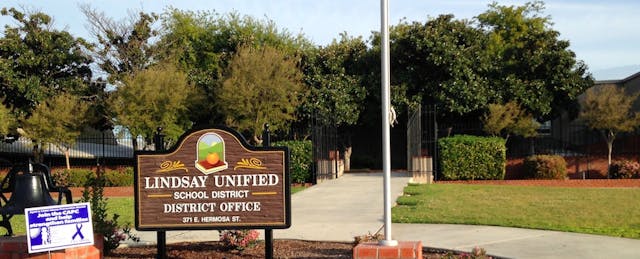Nestled in the orange groves of California’s Central Valley sits a little district called Lindsay Unified that’s getting a lot of attention. With 4,100 K-12 students, all of whom qualify for free and reduced lunch and 52% English language learners, the demographics is much like that in other rural public schools.
However, walk into any classroom and you’ll find neither students nor teachers. Instead, you’ll find “learners” and “learning facilitators.” Nobody gets an “A” or an “F” on anything, and no age-based grade levels exist. Ask a “learner” what he or she is working on and you will get dozens of different answers. But each and every learner knows exactly what they are learning, whether they have mastered it, and what comes next.
“We didn’t just make a tweak. We dismantled our entire education system,” says Lindsay Unified Superintendent Thomas Rooney.
Instead of starting with new technology, grand plans for innovation, or even money (though the district did land a $10 million Race to the Top Grant in 2012 as a result of its new initiatives), the district started five years ago with one very important question: what kind of learners did they want their kids to be?
But transforming a district is far from easy. While the community has embraced the benefits of the redesign, they are also trying to make sense of the challenges. Traditional measures, such as “proficiency scores” or improvements in API have yet to show big gains. But teachers are excited about other measures, notably a dramatic decrease in gang participation and suspension rates. For Lindsay’s leaders, this is all just a single step in their journey to transform education as we know it.
The Past
Five years ago, the district had some serious problems. In 2009, only 25% of students were proficient in reading and only 28% in math. While 76.5% of students graduated from Lindsay’s one and only high school, the class valedictorians who enrolled in colleges in the University of California system were regularly stuck in remediated course work. Some graduates could not even read the local newspaper.
Rooney, a 14-year veteran of the district, is quite forthcoming about his district’s past. “Part of the reason we are making this shift is because of the reality of what happens after graduation,” Rooney explains. “In Lindsay, we have sent forth a lot of kids and young adults into the world who are not ready to be effective contributors to society… I say we own that.”
Before the district began its redesign, the community developed a set of principles that would guide its next steps. They outlined everything from why they exist as an organization, to how they believe students learn best, and even a description of what a Lindsay graduate looks like. These plans were spread throughout the district, in a small church-like pamphlet, written in clear language for everyone to understand and own.
“We believe kids learn in different timeframes and in different ways,” says John Caesar, Director of Technology and 21st Century Learning. “We are committed to these guiding principals and building a system that honors them. That's the key.”
With their guiding principles in hand, they began to dismantle their schools and build what is quickly becoming a leading model for proficiency based learning.
Welcome to the Matrix
Lindsay calls its model a “performance based system,” similar to what others call proficiency or competency-based progression of learning. Instead of advancing at the same rate, regardless of whether they know the material or not, students advance once they have demonstrated mastery of a specific content standard. Once they master the standards within a specific content level, they get to move up and start working at the next content level, regardless of their age or the time of year. Here’s how it works.
The first things learners (students) do when they walk into a classroom is check a large matrix chart at the entrance, displaying the status of each student, the learning standards they’ve mastered and what they have yet to do. The learners navigate the matrix, finding their name, and their scores on each learning standard.

Once learners find the content standard they should be working on they turn to their “capacity matrix.” The capacity matrix displays the content standards along with a list of evidence. Evidence can include assignment such as projects, questions from a textbook, or even role playing, which learners must show to their learning facilitator (teacher) to demonstrate they have learned the material and are ready to take the assessment.
While students work to gather evidence, the learning facilitator brings those on “teacher pace” (students who are progressing through content as expected) together to for a quick lesson on new content. Those falling behind receive one-on-one check in’s; those breezing ahead are given freedom to keep going. Learning facilitators are continually grouping and regrouping learners in their classrooms based on where they are in relation to “teacher pace.”

Once a student shows their evidence to the learning facilitator, that learning facilitator determines whether the learner is ready to take the assessment. They take their assessments on Educate, a digital assessment tool and Student Information System. After earning at least a “3” on a four-point assessment, the learner can move onto the next content standard until they have mastered all the content standards within a level.
With all learners at a different pace, learners are regularly moved in and out of different classes based on each student’s individual progression. Administrators and learning facilitators spend at least 15 hours each week looking through the data, determining whether students should be regrouped according to their levels. In the high school, learners and learning facilitators could be re-grouped as much as every quarter.
Not every student has the same schedule and every situation is different depending on the student’s social and emotional needs. For instance, one 11-year-old is working on a level eight, which is typically for 13-year-olds. However, he doesn’t always connect with his peers at that level. Therefore, the administrators and learning facilitators have arranged to allow him to leave class early to have lunch with his peers.
And still, leaving the cohort model behind is a struggle for some. For instance, one 11-year old girl in a sixth level class was transitioned into a seventh level class once she’d mastered all her math content in the middle of the year. However, after a while she switched back. “I realized I’m an interpersonal learner and don’t feel comfortable around the older learners so I decided I was capable of learning on my own so I went back to my old class where I learned level seven content on my own,” she explains.
But what happens when learners are faster than the school can handle? Learners in the elementary schools who complete all level 8 material are driven to the high school to take classes at the appropriate level, and spend part of their day with older learners. And here’s a bonus: High school students who complete all 13 levels before they turn 18 years old can spend time exploring areas of interest at the local community college for free.
Tools They Use
“We didn't get held up on taking this on because we didn't have the technology. You don't need to have technology to personalize learning, though it does serve as an accelerator,” says Caesar. “What it needs is a system to change practice and put the child at the center.”
With this approach in mind, the district has been careful about adopting new technology. In many classrooms you will still see students working out of textbooks instead of Khan Academy. Paper posters displaying student progress still hang in each room, rather than students solely referring to the Educate platform to check their progress. Only a handful of desktop computers line the wall of most K-8 classrooms.

Caesar says the district deliberately delayed introducing technology. “We’ve built demand for the tech [first],” he says, by creating a complex structure. “Now we put the tech out there and it gets eaten up. We don’t have to convince our staff to learn how to use it.”
This year, however, the district is putting technology to work. Each student in the High School has received a school-issued Acer laptop. A smattering of software tools are also used throughout different classrooms including Socrative, Khan Academy, Lexia, FASTT Math, Fraction Nation, and READ 180. But the district’s biggest technology endeavor is building a new learning management system that fully supports its now-established model.
The district is partnering with 3Shapes, an Alaska-based company and creator of Educate, to build a platform called Empower. The new platform will connect students with content standards, learning resources and digital assessments. It will also provide students with a learning community that will share what each student is working on to create better peer-to-peer connections. The district is currently working with 3Shapes to create a business model that would allow them to share the platform with other schools.

Impact
Is all this disruption and re-design paying off? For Lindsay, it depends what you’re measuring.
Since 2009, scores have risen incrementally. The district has seen a 9% increase in the number of students (grades two to 11) rated “proficient” in English language arts (from 25% to 34%), a 4% increase in math (from 28% to 32%), and 14% rise in science (from 27% to 41%). Scores on the state’s Academic Performance Index (API) have also made modest gains, rising from 644 in 2009 to 691 in 2013.
While the gain on the API outperforms the state average increase of 35-points, Lindsay’s overall proficiency scores are still well below the state average. In California, average proficiency in math was 51% in 2013. In English language arts that average was 56%.
But test scores might not be the best metric by which to measure Lindsay’s success. Because the state requires districts to test students at the level associated with their age, and not their abilities, the scores on state tests don’t entirely reflect the level a student is working at. For instance, a 13-year-old student might have completed 80% of the content in 6th grade. However, she must still take the test for 8th graders.
“I had a hard time giving students content at a 4th grade level and testing for 6th grade. It doesn’t feel right,” says Washington Elementary Principal, Cinnamon Scheufele.
The district has been advised to apply for a waiver from the state, but has yet to do so because, according to Caesar, “We wanted to show how you can reform a district and its practices within the regulatory environment that everybody is within.”
However, the district is seeing gains in other areas of school culture. Since implementation of the new model, suspension rates have dropped by 41% and gang membership has fallen from 18% to 3%. District officials see these metrics as indicators that students see school as a place for opportunity, support, and hope.
Whatever the results, dismantling a 150-year old system isn’t easy. But students seem to be embracing their new opportunities, and embodying a new way of looking at their growth.
“It used to be all about the teacher. Now it’s all about us,” says one 13-year old Lindsay “learner”.
One young student in the sixth level class explains “I was young when we switched but I knew I wasn’t being pushed,” says another, “But now I can be the best at something if I want. It’s a nice feeling--to be capable of anything.”
A group of rowdy boys in a level six math class explain how easy it was for them to make the shift to the new system, “It doesn’t make me feel embarrassed,” one learner says, “Everyone gets a “one” on something. It’s ok to get ones. I can try again, and get help from my friends, and eventually I’ll pass.”


